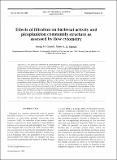Por favor, use este identificador para citar o enlazar a este item:
http://hdl.handle.net/10261/173718COMPARTIR / EXPORTAR:
 SHARE SHARE
 CORE
BASE CORE
BASE
|
|
| Visualizar otros formatos: MARC | Dublin Core | RDF | ORE | MODS | METS | DIDL | DATACITE | |

| Título: | Effects of filtration on bacterial activity and picoplankton community structure as assessed by flow cytometry |
Autor: | Gasol, Josep M. CSIC ORCID ; Morán, Xosé Anxelu G. CSIC ORCID | Palabras clave: | Filtration Bacterial activity Flow cytometry Picoalgae Bacteria Filters |
Fecha de publicación: | feb-1999 | Editor: | Inter Research | Citación: | Aquatic Microbial Ecology 16(3): 251-264 (1999) | Resumen: | We used flow cytometry of autofluorescent and Syto13-stained marine bacteria and the uptake of tritiated leucine to assess the effects of different filter types on picoplankton abundance, community structure and bacterial activity in the filtrate. Coastal and oceanic samples from the NW and SW Mediterranean and the Atlantic coast of Galicia were size-fractionated using polycarbonate (PC), mixed cellulose esters (CE), aluminum oxide (IM) and glass fiber (GF) filters of 0.2 to 1.2 μm nominal pore size from different brands. Flow cytometry of Syto13-stained marine bacteria and autofluorescent photosynthetic prokaryotes was used to analyze picoplankton abundance, size structure and community composition before and after filtration. We combined this capability with the detection of the changes in cell-specific heterotrophic activity in the filtrates. We found that the CE filters retained picoplankton better than the PC filters. The PC filters did not discriminate prokaryotes according to size as much as the GF and the CE filters did. In our hands the IM filters were no better than the CE filters. Bacterial activity in the filtrates increased in the PC and in the CE filtrates and this stimulation of bacterial activity was more important in the less productive environments. We conclude that care must be taken when PC filters are used for generating bacteria-free water, and that the use of CE 0.22 μm filters is the best way of creating picoplankton-free water. However, the picoplankters that will go through the filters may encounter increased nutrient levels. © Inter-Research 1999 | Descripción: | 14 pages, 4 figures, 4 tables | Versión del editor: | https://doi.org/10.3354/ame016251 | URI: | http://hdl.handle.net/10261/173718 | DOI: | 10.3354/ame016251 | Identificadores: | doi: 10.3354/ame016251 issn: 0948-3055 |
| Aparece en las colecciones: | (ICM) Artículos |
Ficheros en este ítem:
| Fichero | Descripción | Tamaño | Formato | |
|---|---|---|---|---|
| Gasol_et_al_1999.pdf | 1,22 MB | Adobe PDF |  Visualizar/Abrir |
CORE Recommender
SCOPUSTM
Citations
116
checked on 29-abr-2024
WEB OF SCIENCETM
Citations
113
checked on 29-feb-2024
Page view(s)
292
checked on 15-may-2024
Download(s)
251
checked on 15-may-2024
Google ScholarTM
Check
Altmetric
Altmetric
NOTA: Los ítems de Digital.CSIC están protegidos por copyright, con todos los derechos reservados, a menos que se indique lo contrario.
